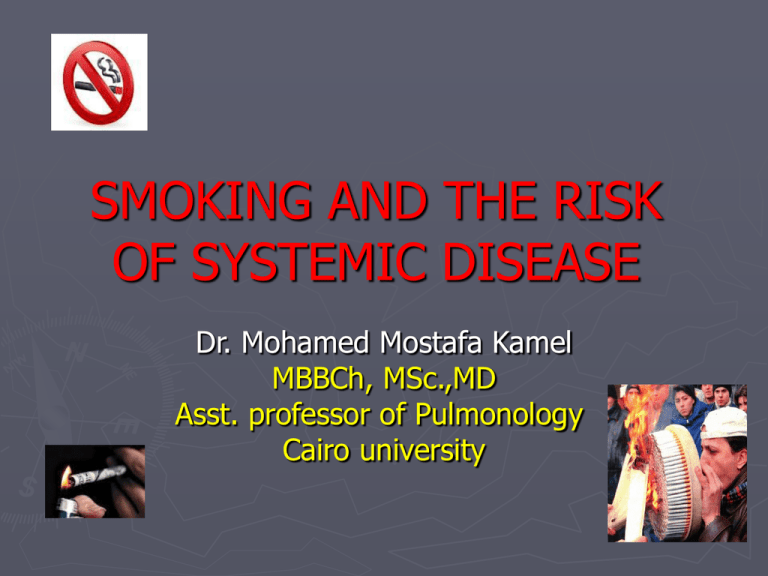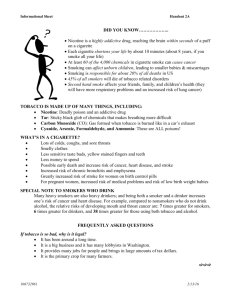SMOKING AND THE RISK OF SYSTEMIC DISEASE
advertisement

SMOKING AND THE RISK OF SYSTEMIC DISEASE Dr. Mohamed Mostafa Kamel MBBCh, MSc.,MD Asst. professor of Pulmonology Cairo university The combustion of tobacco produces a type of smoke that contains more than 4000 substances and chemicals, which are made up of particles and gases that can be inhaled and absorbed into the body. Many of these chemicals are extremely dangerous, not only for the smoker but also for those people nearby. 2005-2012helpwithsmoking.com Three of the main components of environmental tobacco smoke are: Nicotine - an addictive drug as powerful as cocaine or heroin. It alters the brain as well as a person's behaviour and mood. It is also used in insecticides. Tar - a cancer causing substance that damages the lungs. Carbon monoxide - a gas that replaces some of the oxygen in the body that is needed for the lungs to function properly. Carbon monoxide is a poisonous gas, which is also found in car exhaust fumes. 2005-2012 helpwithsmoking.com Some of the carcinogenic substances found in tobacco smoke are: Tar - used to tarmac roads. Arsenic - very potent deadly poison. Cadmium and nickel - used in batteries. Vinyl chloride - used to make vinyl products. Short-term exposure causes dizziness, headaches and tiredness. Long-term exposure can lead to cancer and liver damage. Creosote - a component of tar. If inhaled it can cause irritation of the respiratory tract. Formaldehyde - a preservative substance used in forensic labs. It causes cancer in humans and in animals. Polonium 210 - a radioactive substance that can cause cancer of the liver and bladder, stomach ulcers & leukaemia Other irritant toxins that are found in cigarette smoke are: Ammonia - a pungent colourless gas used in many cleaning products such as window or glass cleaner. Acetone - the main component of nail varnish remover. Acrolein - an extremely toxic substance used to manufacture acrylic acid. It is considered a possible human carcinogen and it irritates the lungs and is the cause of emphysema. Hydrogen cyanide - deadly toxic poison used to kill rats. If breathed in in small doses, it can cause headaches, dizziness and weakness. Carbon monoxide - a deadly gas if inhaled in enclosed spaces. Faulty and leaking gas heaters, boilers, stoves and tobacco smoke all produce this gas. Toluene - used to manufacture paint, paint thinners, nail varnish and adhesives. Low - moderate levels can provoke tiredness, weakness, loss of appetite and memory loss. 2005-2012helpwithsmoking.com Systemic inflammation Systemic oxidative stress Effects of smoking on vasomotor and endothelial function Systemic inflammation Decrease in Neutrophil deformability leading to increase in adherence and migration and eventually to an increase in reactive oxygen species. ERS research seminar2007 Increase in abnormal forms of Neutrophils from bone marrow Increase in cytokines such as IL-6 Chronic smoking increases WBC count which correlates with changes in FEV1 Decrease in number of CD 19 +ve B cells Monocytes show increase expression of CD 11b and CD 18 which increase their adhesion to endothelial cells , together with an increase in ICAM-1 which are important in the pathogenesis of atherosclerosis. ERS research seminars 2007 Systemic oxidative stress Cigarette smoke in the gas and tar phases contains 1015-17 oxidant molecules per puff. It is not surprising therefore that inhalation of tobacco smoke results in local lung, but also systemic oxidative stress. Circulating neutrophils from smokers release increased amounts of reactive oxygen species whose release is further enhanced in COPD patients. Further evidence of increase systemic oxidative stress induced by smoking is shown by increase circulating products of lipid peroxidation and a marked decrease in plasma antioxidant capacity, which may have profound effects on many organs. Cigarette smoking also affects systemic lipid profiles increasing serum cholesterol, triglyceride and low density lipoproteins, but lowering high-density lipoproteins and oxidising LDL. ERS research seminars 2007 Vasomotor and Endothelial Function. Enhanced risk of Cardiovascular disease Decrease in NO and increase in Peroxynitrite which affect vasomotor and endothelial function. Decrease in sytemic arterial wall compliance and increase stiffness. ERS research seminars 2007 Decrease endogenous fibrinolytic activity demonstrated by decrease t-PA release and increase in PAI-1 Increase in procoagulants such as fibrinogen, D-dimer and tissue factor ERS research seminars 2007 CARDIOVASCULAR Increases Nephrotoxicity in old age Increase risk of End stage renal disease Damage to the renal transplant ?? Mechanisms include : - Acute : increase in BP and Intraglomerular pressure - Chronic: Endothelial cell dysfunction. J.Am.soc.Nephrol.15,558-563-2004 INFLUENZA Smoking seems to cause a higher relative influenza-risk in older populations than in younger populations. In a prospective study of community-dwelling people 60–90 years of age, during 1993, of unimmunized people 23% of smokers had clinical influenza as compared with 6% of non-smokers. Nicholson, K. G.; Kent, J.; Hammersley, V. (1999). "Influenza A among community-dwelling elderly persons in Leicestershire during winter 1993–4; cigarette smoking as a risk factor and the efficacy of influenza vaccination". Epidemiology and Infection 123(1): 103–8. ORAL EFFECTS ORAL CANCER LEUKOPLAKIA Smokers melanosis Hairy tongue Submucous fibrosis Leukoedema Tooth decay, abrasions and erosions Halitosis REPRODUCTIVE SYSTEM Impotence Incidence of impotence is approximately 85 percent higher in male smokers compared to non-smokers, and it is a key cause of erectile dysfunction (ED). Smoking causes impotence because it promotes arterial narrowing. Female infertility Smoking is harmful to the ovaries, potentially causing female infertility, and the degree of damage is dependent upon the amount and length of time a woman smokes. Nicotine and other harmful chemicals in cigarettes interfere with the body’s ability to create estrogen, a hormone that regulates folliculogenesis and ovulation. Some damage is irreversible, but stopping smoking can prevent further damage. Smokers are 60% more likely to be infertile than non-smokers. Kendirci M, Nowfar S, Hellstrom WJ. (2005). "The impact of vascular risk factors on erectile function". Drugs Today (Barc) 41(1): 65–74. D echanet, C.; Anahory, T.; Mathieu Daude, J. C.; Quantin, X.; Reyftmann, L.; Hamamah, S.; Hedon, B.; Dechaud, H. (2010). "Effects of cigarette smoking on reproduction". Human Reproduction Update 17 (1): 76 By the American Society for Reproductive Medicine (ASRM). Retrieved on Jan 4, 2009 Psychological Immediate effect: Users report feelings of relaxation, sharpness, calmness, and alertness.Those new to smoking may experience nausea, dizziness, and rapid heart beat. Generally, the unpleasant symptoms will eventually vanish over time, with repeated use, as the body builds a tolerance to the chemicals in the cigarettes, such as nicotine. Stress : Smokers report higher levels of everyday stress. Several studies have monitored feelings of stress over time and found reduced stress after quitting. The apparent relaxant effect of smoking only reflects the reversal of the tension and irritability that develop during nicotine depletion. Dependent smokers need nicotine to remain feeling normal. Gilbert Lagrue, François Lebargy, Anne Cormier, "From nicotinic receptors to smoking dependence: therapeutic prospects"Alcoologie et Addictologie Vol. : 23, N° : 2S, juin 2001, pages 39S - 42 Parrott, Andrew C. (1998). "REVIEW Nesbitt's Paradox resolved? Stress and arousal modulation during cigarette smoking". Addiction 93 (1): 27–39. • Cognitive function : - Alzheimer’s disease : conflicting results.. - Increase in incidence of dementia and cognitive decline, cerebral atrophy, anxiety disorders - Increase in mental concentration similar to caffeine Anstey, K.; Von Sanden, C.; Salim, A.; O'Kearney, R. (2007). "Smoking as a risk factor for dementia and cognitive decline: a metaanalysis of prospective studies". American journal of epidemiology 166 (4): 367–378. Jacobsen, L.; Krystal, J.; Mencl, W.; Westerveld, M.; Frost, S.; Pugh, K. (2005). "Effects of smoking and smoking abstinence on cognition in adolescent tobacco smokers". Biological Psychiatry 57(1): 56–66. Former and current smokers have a lower incidence of Parkinson's disease compared to people who have never smoked. Possible role of nicotine in reducing Parkinson's risk: nicotine stimulates the dopaminergic system of the brain, which is damaged in Parkinson's disease. Other compounds in tobacco smoke inhibit MAO-B, an enzyme which produces oxidative radicals by breaking down dopamine. Quik, M. (2004). "Smoking, nicotine and Parkinson's disease".Trends in Neurosciences 27 (9): 561–568. SKIN DISEASE OTHER EFFECTS Decreases appetite Increases expression of AZGP1 gene that increases lipolysis Increases symptoms associated with crohn’s disease Increase risk of abdominal aortic aneurysm formation Vanni, H.; Kazeros, A.; Wang, R.; Harvey, B.; Ferris, B.; De, B.; Carolan, B.; Hübner, R. et al (2009). "Cigarette smoking induces overexpression of a fat-depleting gene AZGP1 in the human".Chest 135 (5): 1197–1208. Cosnes J et al., (1999). "Effects of current and former cigarette smoking on the clinical course of Crohn's disease". Aliment Pharmacol. Ther. 13 (11): 1403–11 Lung Transplantation Diagnosis N 1 month 1 Year 5 Years COPD AAT 215 85 97% 94% 89% 83% 52% 59% CF 86 95% 63% 46% IPF 57 95% 60% 44% PPH 39 85% 77% 60% THANK YOU







